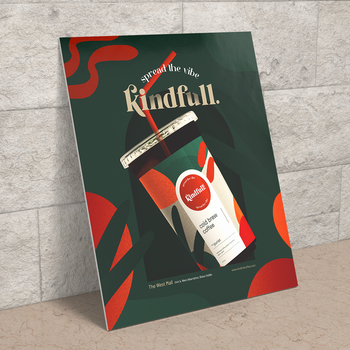Here are a few ways to safely hang posters on any wall.
Posters are a combination of text and images on printed media. These are mostly used to promote products, services, ideas, or events. They can also be artworks installed and framed for decorative purposes or even as graphics that provide instructions to passersby.
Posters are very versatile. There are many places where they can be displayed, from homes, dorms, and rentals to offices, businesses, establishments, and streets. Suppose you’re planning to hang posters in a temporary space such as a rental. In that case, using materials such as nails, staples, tacks, tape, or other adhesives is not advisable because these can leave permanent marks on the wall, strip off paint, or even damage the poster itself.
This guide will show you how to hang your posters without damaging anything, whether the poster itself or the walls.
Looking for custom posters? Trust UPrinting to do the job. We offer colorful, high-quality posters that immediately grab attention. Create your design by downloading our free templates or uploading your ready-to-print file.
Step 1: Preparations
Before you start hanging your poster, it’s important to make a few preparations. These are:
Think of the Space You’ll Use
Where are you going to place your poster? Is it in a rented space or a permanent area? Do you plan to hang the posters temporarily, or do you plan to swap posters frequently? Is the surface smooth or textured? These are the things to consider before you start installing.
Keep Your Hands Clean
This might be a small thing, but ensuring that your hands are free from oil, grime, or dirt will prevent your poster from having fingerprints or smudges. This is especially important if your poster has a glossy finish or is printed on photo-quality cardstock.
Prep Wall Surfaces
Any effort to hang your poster will be in vain if your wall surfaces are not prepped enough for installation. If you use an adhesive, your poster won’t stick if the surface is dirty or oily. Clean every surface, get into every nook and cranny with a rag, and use warm water or a cleaning agent to ensure that every space is squeaky clean. Also, ensure the wall is completely dry before applying the poster.
Keep the Poster as Flat as Possible
If your poster isn’t framed or rolled, it’s a must to flatten it out first. To do this, lay the poster on the floor and weigh it down at the corners for a few hours using books or heavy items. This will keep your poster from curling back and help make hanging your poster easier.
Step 2: Choose Easy and Safe Ways to Hang Your Poster
1.) Double-sided removable tape/poster tape
As strange as it seems, not everyone knows there are products specifically designed to help you mount posters without marking or damaging the poster or the surface on which you need to mount it. Just be sure you use the correct tape and that all surfaces are clean. Choosing the wrong kind of poster tape can result in a gunked-up wall or a poster that tears apart when you remove it.
2.) Magic tape
If you don’t have access to double-sided adhesive, the Magic tape will do in a pinch. Unlike regular scotch tape, the Magic tape is not as “tacky” and will easily detach from your posters, even after months or years of use, depending on the climate. Another plus is that the Magic tape is virtually invisible on smooth surfaces.
3.) Removable putty
We would only recommend putty on mounted posters or posters printed on a rigid material. Using too much putty on paper or even card stock posters may cause some rumpling at the contact points, which you wouldn’t want if you’re going for a neater look. Avoid fresh or poorly painted surfaces, as you might remove some paint when you take down the poster.
4.) Toothpaste!
This might sound like a dumb way to hang posters, but toothpaste – not to be confused with tooth gel – can safely attach posters to most surfaces for a few days. The cheaper, the better. Don’t use anything with additional additives or whiteners, as this makes for poorer adhesion. The best part is that it’s easy to clean and leaves surfaces undamaged, which is ideal if you’re in a rental property.
Other options:
These other methods won’t leave your posters or your wall pristine, but they’re better than nothing.
1.) Thumbtacks
Instead of poking a hole through your poster to hang it, as you’d typically do with tacks, use them, so the points are just outside the edge of the paper but close enough so that the tack heads can still hold them against the surface. We’d only recommend this for unfinished or rough wood surfaces and corkboards. This is best done on cardstock posters or those made from heavier paper stock.
2.) Slide binders
Thread these binders through your posters’ top and bottom edges and thread a string on the top edge. Now you could hang your posters from rods, screws, nails, or wherever you need them. The bottom binder will give it more weight so it can hang properly.
3.) Binder clips
Use multiple binder clips from their edges to hold posters and photo enlargements – or smaller prints like postcards. You can hang them from lines, hooks, and screws against or away from walls. This approach might look sloppy and isn’t really recommended in all situations. The clips may also create indentations on your posters, though using bulldog clips instead of the more common standard binder clips can help you avoid this problem.
4.) Heavy-duty mounting tape
Unlike poster tape, heavy-duty mounting tape can safely hold objects weighing several pounds to a wall. Mounting tape is often used to semi-permanently secure items to walls that you couldn’t drill or drive nails through. It’s overkill for most posters, except perhaps ones printed on heavier materials like plastic or coroplast. It’s way too easy to tear paper and card stock posters attached to walls with mounting tape, so it’s best to use this method when no other options are viable.
Step 3: Attach Adhesive to the Back of the Poster
To prevent your poster from falling, attach the adhesive to the back of the poster. Ensure that the adhesive on all contact points is enough to secure the poster. Don’t just stick it in place. Flatten it, too, and keep it secure on the wall.
Step 4: Hang/Place Your Posters
Since your poster is ready and the place where you’ll hang it has been prepped at the beginning, the final step is to put it up for display.





Leave a comment